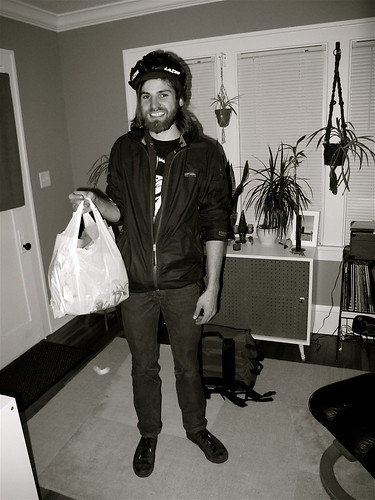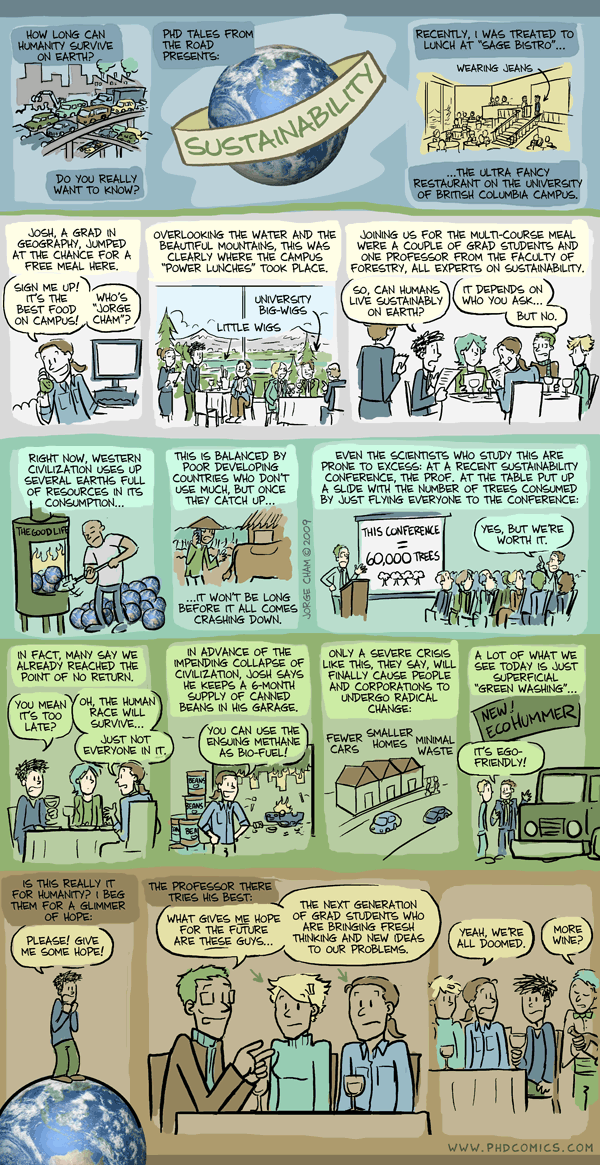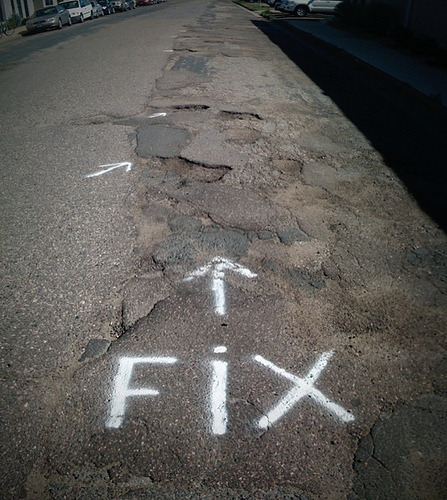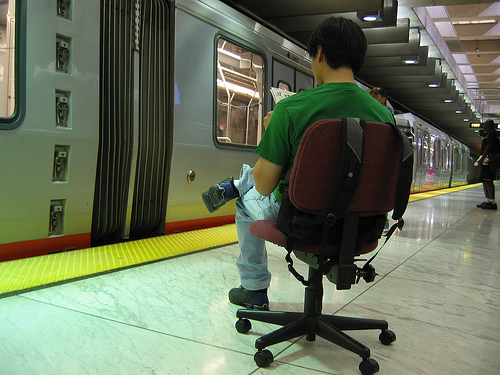Suddenly the City
I live in seems interesting
as if I were on vacation here
and feeling indulgent
towards the human race, its way of living in cities and
tearing up roads so the traffic has to be
re-routed around a collapsing white mesh barrier
as in this intersection here.
The people of this city
walking back and forth on the sidewalks
each one having gotten up and dressed this morning
look like this, this
movie, almost, of people crossing the street.
The questions,
is this scene in any way rewarding to look at?
e.g. architecturally, in terms of city spaces and human interest; and
are things diverse enough here? and
are these people, in general,
older or younger than I am? just now are
in abeyance. In their absence is this
pleasant sense that there are many cities in the world
and this is one of them.
It rained earlier. I think I'll go see the monks
make a sand mandala on the Esplanade; and
who knows, later I might get a sandwich.
2011-03-29
2011-03-25
*** Sidewalk Weekend! *** #53
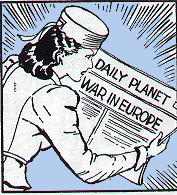 Sidewalk Rating: Now With More Daylight!
Sidewalk Rating: Now With More Daylight![Bike rental sign-holding guy near Columbus Circle, New York City.]
The faces are filled
with gourmets, with smokers;
the theaters are packed
with cheerful spectators.
The arcades are swarming
with gawkers, with enthusiasts,
and pickpockets wriggle
behind the flaneurs.
*** ***
[Click on images for links!]

*** ***

*** ***

*** ***
*** ***
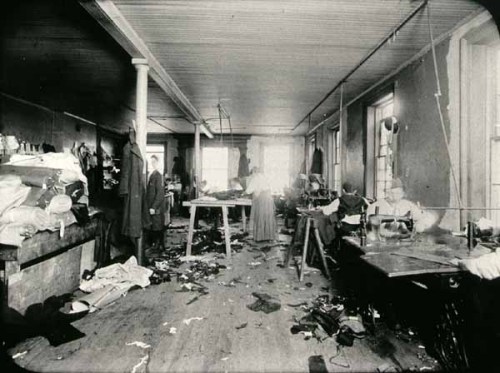
*** ***
Minnesota's unemployment rate has been typically better than the national average, but black Minnesotans have a jobless rate of 22 percent compared to 6.4 percent for whites — the biggest racial disparity in the nation, the Star Tribune reports.
[TCBJ]
2011-03-22
Reading the Highland Villager #33 (March 9 - 29 Edition)
 [Basically the problem is that the best source of Saint Paul streets & sidewalks news is the Highland Villager, a very fine and historical newspaper. This wouldn't be a problem, except that its not available online. You basically have to live in or frequent Saint Paul to read it. That's why I'm reading the Highland Villager so that you don't have to. Until this newspaper goes online, sidewalk information must be set free.]
[Basically the problem is that the best source of Saint Paul streets & sidewalks news is the Highland Villager, a very fine and historical newspaper. This wouldn't be a problem, except that its not available online. You basically have to live in or frequent Saint Paul to read it. That's why I'm reading the Highland Villager so that you don't have to. Until this newspaper goes online, sidewalk information must be set free.]Total # of articles about sidewalks: 12
Total # of articles about sidewalks written by Jane McClure: 12
Headline: University Ave. businesses lay out light-rail woes
Reporter: Jane McClure
Short short version: [In what is sure to continue to be a fortnightly front page story for the next three years] University Avenue business owners are concerned about light rail construction. Story comes from a University Avenue Betterment Association [née University Avenue Business Association] rally involving "picket signs and makeshift coffins" carried "under the watchful eyes of three Metro Transit police officers." Concerned parties interviewed: owner of Ax-Man. [That's it!] The city argues there will only be a small drop in revenue of less than 3%. [You'd think they could have come up with a more believable number?] Also quotes city official Nancy Homans on the $1.3M program to improve off-street parking lots. [See below. -Ed.]
Headline: City working to provide more off-street parking on University
Reporter: Jane McClure
Short short version: The city is "eying" vacant properties along University to think about off-street parking, including Midway Chevrolet, the [flagrantly code violating] ex-restaurant Kim Huoy Chor, and the site just west of CVS Pharmacy owned by American Bank. Quote from CM Russ Stark.
Headline: Residents review plans for school, apartments at Victoria Park
Reporter: Jane McClure
Short short version: West 7th Street neighbors are OK with a charter school going into the new Victoria Park development, but 155 apartments make some people upset... "too tall," "infringe on privacy," "density," &c &c.
Headline: District rejects proposals for using old Howe School in Minneapolis
Reporter: Jane McClure
Short short version: Minneapolis Public Schools didn't like any of the proposals that were proposed for the old Howe School on 43rd Ave South. Proposals rejected include: arts lofts + townhomes, single-family homes + housing disabled veterans, using the building for the charter school mentioned above. The district might just sell the property on the "open market."
Headline: Commission recommends amended plan for rezoning in Central Corridor
Reporter: Jane McClure
Short short version: [Following the earlier controversy over zoning changes along the LRT route,] The St Paul Planning Commission approved new zoning changes. They are different from the initial proposal mainly because this iteration caves to pressure from the St. Paul Port Authority and "auto-oriented businesses" and has a smaller area that would be rezoned Traditional Neighborhood "TN," which would make auto-oriented and industrial uses non-conforming. Instead of 98 non-conforming business, there will only be 60. [Seems dumb to me. I wonder which Wendy's or Jiffy Lube got the OK to expand? -Ed.]
Headline: Light-rail station area plans reviewed
Reporter: Jane McClure
Short short version: There was a public hearing for light-rail station area plans at the new stops at Hamline, Victoria, and Western. 30+ people were there. [Doesn't seem like much happened though.]
Headline: Demolition of Bureau of Mines buildings still awaiting funds
Reporter: Jane McClure
Short short version: Some sort of Mississippi Parks agency is waiting for money from the Federal government to demolish the abandoned Bureau of Mines buildings. Obama put some money into his budget, but it hasn't been approved. Even if approved, the amount of money is probably too small to get all the work done.
Headline: Hearing set on new ordinance regulating 'hookah lounges'
Reporter: Jane McClure
Short short version: [Yes, the Villager still puts hookah lounges in scare quotes.] The 'City Council' is having a 'hearing' on how to 'regulate' hookah lounges, which apparently confuse and scare everyone. [See? I can use scare quotes too. This already happened, on the 16th. -Ed.]
Headline: Commission favors Schmidt's historic status
Reporter: Jane McClure
Short short version: The Planning Commission recommended "local designation" for the brewery and the area surrounding it. This will help with the development plans.
Headline: Permit granted for proposed Ramsey Hill bed and breakfast
Reporter: Jane McClure
Short short version: An abandoned mansion on Dayton Avenue got the OK to become a B&B.
Headline: On-sale liquor licenses in store for two local establishments
Reporter: Jane McClure
Short short version: "Rusty Taco" restaurant on Lexington next to Traitor Joe's and the new owners of the classic steakhouse The Lexington, also on Lexington, will likely get liquor licenses.
Headline: Area residents sound off on plan for new parks on Ford Plant site
Reporter: Jane McClure
Short short version: There was a meeting about the plans for parks to be included in any future development on the Ford Plant site. [Covered here earlier.] Reactions were "mixed." E.g., "Not enough river views" and "How can the city pay for parks?" and "Why are we here?"
Labels:
LRT,
Mpls,
parking lots,
parks,
reading the highland villager,
stpaul
2011-03-21
Remembering Ruth Adams
 Whenever anyone asks me where to take someone visiting the Twin Cities from out of town, my answer always begins with the words "Nye's Polonaise Room." And one of the big reasons for that was the presence of Minneapolis legend, Ruth Adams, who began playing polka music there on a tiny stage located right next to the bathroom way back in 1975. She was part of The World's Most Dangerous Polka Band, and seeing them play was one of those things you could absolutely rely on, like Mickey's Diner being open or Tim Pawlenty's self-aggrandizement.
Whenever anyone asks me where to take someone visiting the Twin Cities from out of town, my answer always begins with the words "Nye's Polonaise Room." And one of the big reasons for that was the presence of Minneapolis legend, Ruth Adams, who began playing polka music there on a tiny stage located right next to the bathroom way back in 1975. She was part of The World's Most Dangerous Polka Band, and seeing them play was one of those things you could absolutely rely on, like Mickey's Diner being open or Tim Pawlenty's self-aggrandizement.This is my Ruth Adams story. It was a December evening a few years back, and my friend and I were on our way to a downtown condo for a Christmas party. And, unlike this year, that winter was dry, brown, and colorless. We hadn't had more than a flake of snow.
My friend and I stopped by Surdyk's to pick up a tasty beverage to bring to the party. We found a bottle of soju (my friend was Korean), but for some reason the store was oddly empty. This emptiness was all the more obvious because Surdyk's was having some sort of promotion where they'd mined the store with young women in Santa-themed outfits standing behind podiums giving away free booze. You could literally walk around the store and bored people would just hand you free samples and chat with you. So we did.
No little time later we emerged from Surdyk's feeling refreshed, and that's when it became apparent why the store had been so deserted. It was snowing! And it wasn't just any snow, but that beautiful first snow of the winter that makes you really excited. I know it's hard to think about enjoying snow in March, but there's a magic about that first snowfall every year that escapes description. And that's the snow that was coming down all around us as we walked toward the Central Avenue Bridge to the party.
I remember hearing Nye's before I even saw it. The streets were pretty empty, and there was that dampening snow-effect where someone turns down the volume of the city as the snowflakes absorb the soundwaves. The noise of cars disappeared and Minneapolis became smaller, zooming in until it seemed like there was nothing beyond Hennepin Avenue. Instead, all I could hear were the soft big band tunes coming out of the outdoor speakers at Nye's, lit up in the fading light as flakes glided onto their red awning.
Just then a red Jeep pulled up to the curb, stopping right in front of the Nye's Polonaise Room's front door. A middle-aged man opened up the driver's door. He looked vaguely familiar in his coat, but I couldn't place him until he called over to me. "Hey can you give me a hand?" He was the trumpet player for the World's Most Dangerous Polka Band.
"Sure," I said. And I hesitantly approached the SUV. The man walked round the hood and opened up the passenger door and there was Ruth Adams looking mighty tired, bundled up in a thick coat and (if I recall) pink sweatpants.
"Would you help her inside?" asked the trumpeter.
And so, gentlemanly, debonair, and smiling in the twilight, I held out my elbow and Ruth Adams took my arm. She didn't say anything. She was surprisingly heavy and seemed very fragile, and we walked together slowly, carefully through the newfallen snow, and through the front door of Nye's Polonaise Room as Sinatra sang out onto Hennepin Avenue. And I've never felt more at home in Minneapolis than in that moment.
Ruth passed away last week. She was 79, and she's made more people smile than I could ever hope to.
2011-03-09
Notes from The Saint Paul Transportation Summit - March 9, 2011
The University Club building is very fancy, though much less fancy then it used to be, as it now houses outreach offices for the College of St. Scholastica and Lifetime Fitness (?). But, regardless, there is still a huge fireplace and 100% marble plated bathrooms and a player piano, and it is here in the 3rd floor ballroom where I find the Saint Paul SmartTrips 2011 Saint Paul Transportation Summit.
This is a high ceiling'd ballroom, and in the back of the room someone has put together three or four tables, and there I find all the usual players: MNDOT touting the new Lafayette Bridge, HOURCAR, the soon to be expanded NiceRide, the Central Corridor outreach crew, a group from the Midway Chamber of Commerce with a new "buy local" campaign called "Discover Central Corridor" (or something like that), MetroTransit, a Union Depot guy, a guy from the Saints pushing the Lowertown stadium, folks from Sibley Bike Depot, and Dero bike rack company with something called the ZAP.
After some mingling, we sat down at the tables (each marked with a different category, somehow organized according to roles like "advocacy" or "promotion") and proceeded to get coffee, fruit, and a sandwich while listening to talk about the tranportation future of Saint Paul. I'd say that about 40% of the room was business types, represnting a business or organization that might be affected by transportation or the impending light rail construction, 40% were transportation professionals working for one of the orgs or planning offices, and the rest were advocates or community group people (like myself).
We heard:
Mayor Coleman ...
- ... mention that Saint Paul has, not just a sustainability coodinator, but a sustainable transportation coordinator on staff.
- ... argue that sustainable transportation can appeal to Council Members if we think about "the economics of it" and about how constituents need access to transit
- ... claim that bike paths combine health, safety, and time saving benefits
- ... describe how he can "sell his city to business owners" by talking about transportation infrastructure
- ... explain that urban economic concerns are driven by policy and environmental choices
- ... use the excellent metaphor that "you don't look at your feet to see where you're going, you look out at the horizon" to discuss how these changes would have impacts far into the future.
Council Member Russ Stark ...
- ... delicately understate that the last few years have seen a number of "healthy debates" where the "level of conversation is higher" around transportation issues, particualrly the Central Corridor, bikeways, and bike lanes
- ... explain how the Planning Commission's new Transportation Committee has replaced the old Bicycle Advisory Board, so that you don't just have "bike people talking to bike people" but bicyclists talking to transit folks talking to motorists, etc.
- ... add that this previous change led to the birth of the Saint Paul Bike Coalition, who are now free to do advocacy
- ... admit that you can change policy (e.g. Complete Streets) but that doesn't actually translate in changing the practices on the ground (e.g. St. Paul Public Works)
- ... reveal that his #1 priority is to make the city safe for pedestrians, and there will be a new program aimed at city staff to educate people about safe driving for all
- ... expound that pedestrian safety is "important for cities" and impacts "why people live in cities" in the first place
- ... offer, for example "State Highway 51", a.k.a. Snelling Avenue, that is a great example of this because in the last 10 years, 150 cyclists and pedestrians have been hit by cars on this street, leading to 7 fatalities
- ... and argue that there is safety in numbers, that Complete Streets make it safer not just for pedestrians and cyclists, but also for drivers, i.e. traffic calming makes it safer for everyone!
The MetCouncil's Central Corridor outreach person Robin Caufman ...
- ... outline the timeline for LRT construction in very specific detail, especially downtown
- ... mention, for example, about how Cedar Street between 5th and 7th Streets will be closed from June 2011 until November 2012 (!)
- ... mysteriously use the acronymn "TMO"
- ... and how in April they will be demolishing the Bremer Bank building, but also replacing the skyway there (for some reason, no doubt to appease skyway owners elsewhere)
John Siqeland (sp?) from Metro Transit ...
- ... also use the acronym TMO right out of the gate to refer to the SmartTrips folks, which I would guess means "Transportation Management Organization"
- ... drop the word stakeholders three times
- ... put up a graph of increasing ridership since 2004 (following the transit strike, which really cut into ridership numbers)
- ... talk about how GPS trackers on buses, installed since 2005, have made them more on time (even though his graph of 'on time percentage' didn't really back him up)
- ... talk about how park and ride users have doubled since '03
- ... mention the new "student pass" program aimed at high school students
- ... (after a question from Michelle Dilbee at TLC) talk about prospects for the state budget this year, and how Governor Dayton's budget has taken "material cuts to transit" off the table
- ... use the excellent metaphor "larger piece of a shrinking pie" to discuss transit's MVST funding stream.
Finally, you had Damian Goebel from Saint Paul SmartTrips ...
- ... lead everyone in multiple rounds of applause
- ... mention the telework policy program
- ... and the commuter challenge
- ... the Bike/Walk week
- ... Commuter Challenge Award
- ... "programs" in neighborhoods.
Labels:
bureaucracy,
local business,
LRT,
politics,
public policy,
skyways,
stpaul,
Transportation
2011-03-08
Cars, bikes, and the steering wheel's pernicious political stranglehold
 [Brooklyn Borough President Marty Markowitz riding a tricycle to score cheap political points by crapping on bikes.]
[Brooklyn Borough President Marty Markowitz riding a tricycle to score cheap political points by crapping on bikes.]As a Bicycling and Walking Obsessed Individual (yeaaa BWOI), there's nothing that gets me down like anti-bike lane backlash. Just when you finally pull enough strings, get someone elected, somehow get a DOT to pay for some decent bike or ped infrastructure, along comes some politically-connected schmuck driving around in their Robert Moses-mobile who all of a sudden has to deal with a bumpout or an actually enforced speed limit or driving an extra block to park their Lincoln, and the next thing you know they've got Congressman Douche-Whiner on the the phone and the next next thing you know he's in a meeting with your mayor saying things like this:
“When I become mayor, you know what I’m going to spend my first year doing?” Mr. [Douche-Whiner] said to Mr. [Mayor], as tablemates listened. “I’m going to have a bunch of ribbon-cuttings tearing out your [expletive] bike lanes.”
And maybe its my fault for actually paying attention to New York City politics, but this kind of asinine crap seems to happen everywhere that's experiencing a “bike revolution.” Granted New York is a special place where common sense goes to die, but this same kind of thing happens here too in the Twin Cities, or also Toronto comes to mind, or Wisconsin, or probably lots of other places that I don't know about. It seems that just when you think you're making progress, you find yourself at the business end of a Nissan Armada.
[In America, somehow this makes sense.]
As I said, there's nothing more frustrating than the chokehold that the steering wheel seems to have over our American psyches. Why is it so difficult to make a few little changes to the urban landscape?
To some degree, I can understand how we got to this depressingly auto-choked political impasse. The typical American is conceived in the back seat of a car, spends their infancy in and out of car seats, grows up playing with toy cars and getting driven to and from school, music lessons, and sports practice until they turn sixteen at which point they go through a rite of passage and get their driver's license. Then they spend the rest of their adult lives driving around for hours each day, working to pay for insurance and gas and car repairs, driving to and from work and school, driving home to watch NASCAR races, spending weekends polishing their chrome, and falling asleep each night to nightmares where they're searching for the last parking spot in the city. This goes on until one day they lose their job and off themselves by sucking on their tailpipes in their attached three-car garage and are taken away in a hearse. End of story.
 Well, that's not true for everyone. But it did happen in American Beauty, or something. And it illustrates the extent to which, like Johnny Knoxville in Jackass: The Movie, we've shoved automobiles up our collective posteriors.
Well, that's not true for everyone. But it did happen in American Beauty, or something. And it illustrates the extent to which, like Johnny Knoxville in Jackass: The Movie, we've shoved automobiles up our collective posteriors.What else could explain how tightly we cling to our cars, despite the strain and stress and ever higher gas prices?
I'd have to guess that it's the extremes that make car politics so pernicious. On the one hand, the car commercial freedoms: speeding through a city at night, winding down a windy mountain road with the top down, the limitless convenience of going right from your doorstep to your destination 50 miles away in under an hour, filling the trunk with all your crap from Target and bringing it right into your home, the road trip with family or friends that speeds you out of the city and into the great unknown. When everything's working correctly, nothing short of heroin is more intoxicating than the happy motoring lifestyle.
On other hand, there's the reality of the terrible world of actually existing driving. You know, that that all-too-rarely lives up to the dream? Constantly getting stuck in traffic, searching for parking spaces for block after frustrating block, going to the gas pump and helplessly watching that terrible number get larger and larger as you squeeze the nozzle spewing fumes into the fluorescent air, that inevitable problem with the [insert expensive part of car here] that forces you to submit to mechanical extortion. The downside of car culture is really terrible, and more than anything it's these extremes that give bike-backlash car politics so much traction, that make these sort of appeals so appealing. As if a little change, building a new freeway or getting rid of the bike lane, will somehow magically make all the frustrations of driving disappear into the rear view mirror.
From my bike and walk-centric perspective, these bike lane backlash stories are incredibly frustrating. Is it so much to ask, when all this space and infrastructure and attention and money is thrown at this problem of car frustration, for a little bit of space on the street devoted to an alternative? For a safe and comfortable lane for cyclists, or for calming measures that make it pleasant to walk down a city street? Are these extra 4 parking spots, or having to drive five miles per hour slower through a residential neighborhood, such tremendous sacrifices for US drivers? Is it too much to ask that our city streets be comfortable, quiet, and safe places to experience life freed from a windshield?
The sad truth is that, as much as I want to see a biking and walking revolution, until non-motorized transportation achieves a critical mass (or until the gas price goes up even farther), we're going to have to fight like hell for every square foot of space on US roads. For every two steps forward, there's a step back. And this is true even in a place like New York City, which has the lowest rate of car ownership in the country. If they can't build a bike lane in New York without a knock down drag-out fight to the death with every hyperactive politician who can make hay catering to stressed out soccer moms and political big wigs who like to park on the sidewalk in front of city hall, how will they do it in Omaha or Orlando?
The bike snob says it best yesterday in a rare moment of non-snark:
Sure, Weiner isn't necessarily going to get elected, but given the way most people seem to feel about bike lanes and cyclists these days I can't imagine any candidate actually expressing any support for them during a campaign. Sure, once all the bike lanes are gone there are plenty of us who will keep riding anyway. After all, we've already spent years as the rats on the subway tracks, dodging and parrying as much larger machines bear down upon us, so it won't be very difficult for us to revert to our survivalist behavior. No, I just feel bad for the regular people with no particular interest in being lifestyle cyclists or becoming part of the "bike culture" who just want to be able to hop on a bike and get stuff done. At any rate, it should be amusing in a few decades when other cities actually have modern streets and people in New York City are still dodging Lincoln Navigators.
If we're really going to make biking and walking progress in my lifetime in the US, we've got to start letting go of our steering wheel, lose the tail light myopia, and begin to gradually leave our cars behind. But this seems like such a big task, and often seems like its an all-or-nothing affair.
Meanwhile, some days, being a biker and pedestrian (advocate) can feel awfully Quixotic.
2011-03-07
Planning Blunder #8: The Franklin / Hiawatha / Minnehaha intersection
 Why it’s dumb: Huge dual freeway and rail over/underpasses in the middle of a dense walkable neighborhood creates an impassable pedestrian wasteland barrier.
Why it’s dumb: Huge dual freeway and rail over/underpasses in the middle of a dense walkable neighborhood creates an impassable pedestrian wasteland barrier.What they were thinking: As best I can tell, the origins of current clusterf**k date back to the construction of the freeway along Hiawatha Avenue, which is one of the first things that Minneapolis and the Minnesota DOT did following World War Two.
 Following the war, the intersection of Franklin and Minnehaha had two things going against it. First, it was the site of a big railroad interchange that belonged to the Chicago, Milwaukee, Saint Paul, and Pacific Railroad Company, which had a railyard just north of Franklin at the site of the current LRT maintenance facility.
Following the war, the intersection of Franklin and Minnehaha had two things going against it. First, it was the site of a big railroad interchange that belonged to the Chicago, Milwaukee, Saint Paul, and Pacific Railroad Company, which had a railyard just north of Franklin at the site of the current LRT maintenance facility.Second, the intersection lay in the path of a proposed freeway plan that city transportation engineers envisioned along Hiawatha Avenue, that would eliminate congestion by speeding the booming number of cars Southeast out of Downtown Minneapolis all the way to Fort Snelling. This project killed two birds with one stone, and creating a new urban freeway and elevating the train tracks over Franklin’s at-grade railroad crossing.
 [The program for the Cedar Avenue Grade Separation ribbon cutting ceremony on November 9, 1950 featuring a parade, a performance by the South High Band*, and a speech by Albert Bastis, chairman of the Post War Progress Committee.]
[The program for the Cedar Avenue Grade Separation ribbon cutting ceremony on November 9, 1950 featuring a parade, a performance by the South High Band*, and a speech by Albert Bastis, chairman of the Post War Progress Committee.] [The gradual disintegration of the Franklin / Minnehaha / Hiawatha intersection, from 1938, 1954, and today. CLICK TO ENLARGE.]
[The gradual disintegration of the Franklin / Minnehaha / Hiawatha intersection, from 1938, 1954, and today. CLICK TO ENLARGE.] My take: Along with Lake, Central, and University, Franklin Avenue is one of the most pedestrian-oriented, diverse, and vibrant streets in the Twin Cities. It has a rich mixed-use walkable infrastructure, and happens to run through some of the most under-served communities in the city. And, at least these days, for the most part Franklin is pretty well designed and a pleasant street on which to walk or bike or shop or hang out.
Well, all except for the half-mile stretch between 19th and 15th Avenues where Franklin becomes a complete hell on earth, running through and under what have to be the least-inviting underpasses this side of Detroit. The current intersection has all the aesthetic appeal, pedestrian conveniences, and warm secure feelings of the dungeon levels from Super Mario Brothers.
Today, looking at the corner where these three streets come together, you might think that they’ve always been this way, that these corners have always been a pedestrian nightmare filled with rail tracks and freeways.
But, looking back at what the corner was like before the “Post War Progress Committee” completed their plan for “Progress in the City of Minneapolis,” the corner used to be a neighborhood street with rail tracks running through it. Where today you’ll find freeways and overpasses and endless amounts of concrete and car lanes, there used to be nothing but (probably slapdash) homes and shops along Franklin with a rail line running through them.
And then someone got the great idea to build a freeway along Hiawatha, and used the opportunity of the at-grade rail crossing to extend the road into the middle of Franklin and all the way into to downtown. And it was this move that really separated the Phillips / Stevens Square part of the city from the West Bank / Seward part of the city, creating two separate Franklin Avenues that to this day have remarkably different characters and characteristics.
Its hard to really blame the car-blinded Progress Committee. This was the very beginning of the freeway construction era, and I’m sure building as many lanes of car capacity as possible was seen as an unmitigated good.
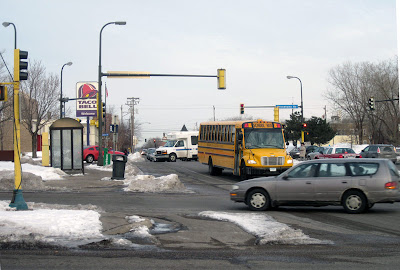 [How to walk on Franklin from 15th to 19th Avenues. Step #1: Negotiate the five lanes of speeding traffic coming off Minnehaha and Hiawatha Avenues.]
[How to walk on Franklin from 15th to 19th Avenues. Step #1: Negotiate the five lanes of speeding traffic coming off Minnehaha and Hiawatha Avenues.] [Step #2: Wait for long time at small concrete island in between 4 lanes of traffic. Cross street. Repeat Step #2.]
[Step #2: Wait for long time at small concrete island in between 4 lanes of traffic. Cross street. Repeat Step #2.] [Step #3: Walk along dark concrete pillared corridor underneath train tracks.]
[Step #3: Walk along dark concrete pillared corridor underneath train tracks.] [Step #4: Cross large "no-man's land" on-ramp area and repeat Step #3 process for dark concrete underpass underneath freeway.]
[Step #4: Cross large "no-man's land" on-ramp area and repeat Step #3 process for dark concrete underpass underneath freeway.] [Step #5: Walk up hill along barren empty (ice-caked) path until you are finally in an area surrounded by buildings again. Total distance covered: 1/2 mile.]
[Step #5: Walk up hill along barren empty (ice-caked) path until you are finally in an area surrounded by buildings again. Total distance covered: 1/2 mile.]But to this day, we’re still living with the legacy of the unfortunate decision to place a freeway in the middle of Franklin Avenue. We’ve spent a lot of time and money trying to undo this particular bit of progress, re-designing the corner in a futile attempt to make it work for both the giant stream of car traffic and the large number of pedestrian, bike, and transit users in the area, all while trying to cultivate density around the light rail station.
There are options for improving this corner, the most obvious being a roundabout-style intersection with lots of crosswalks. (Not sure how that would work…) But its almost impossible to imagine any sort of decent transit friendly walkable treatment for this corner that didn’t involve getting rid of the Hiawatha freeway that funnels thousands of cars into the neighborhood. As it is now, the Hiawatha /Minnehaha/ Franklin clusterf**k corner is a lost cause. For the entire ¼ mile radius of the Franklin LRT stop, as there is nothing here but concrete and freeway overpasses.** And that’s why it’s the #8th worst planning blunder in the Twin Cities!
 [For what its worth, these two sides of Franklin Avenue might as well be separated by a giant moat filled with sharks with freakin' laser beams on their heads.]
[For what its worth, these two sides of Franklin Avenue might as well be separated by a giant moat filled with sharks with freakin' laser beams on their heads.]* Not the same South High.
** And the Cabooze.
** And the Cabooze.
Labels:
Mpls,
planning,
trains,
walkability,
worst planning contest
2011-03-04
A successful BURP!
I'm happy to report that the 1st ever BURP (Buffs of Urban and Regional Planning) had a successful outcome yesterday at the Nomad World Pub on Cedar Avenue. Drinks were consumed, planning issues were discussed, urban nostalgia was had by all.
Topics discussed included:
Thanks to Alex, Matty, Mike, Dudley, Stephen, and Tera for stopping by.
Topics discussed included:
- Documentary filmmaking
- Tilt shift lenses
- The lengths of everyone's commutes
- The Metropolitan Building (in no little detail)
- Urban exploration
- Korea
- Airports
- Oil prices
- Politics
- The peripheral location of jobs
- Montreal
- The Central Corridor
- And many many other things
Thanks to Alex, Matty, Mike, Dudley, Stephen, and Tera for stopping by.
Labels:
announcement,
beer,
BURP,
Mpls,
pontification,
social capital
2011-03-02
1st BURP Happy Hour Tomorrow at the Nomad
For a little while now I've been wanting to try out a semi-periodical urbanism themed happy hour get together. And I'm happy to announce that the first one will be tomorrow at the Nomad World Pub on Riverside Avenue at 5:30.
The group is called BURP (Buffs of Urban and Regional Planning), an fittingly urban planning-type acronym provided by Alex Bauman. We will hang out and drink 2 for 1 beer courtesy of the Nomad World Pub.
Stop by if you're in the Minneapolis neighborhood and want to talk about sidewalks, planning, the history of Cedar-Riverside, bikes, or anything else that's on your mind. Get rid of those still-winter blues the only tried and true way: with beer!
The group is called BURP (Buffs of Urban and Regional Planning), an fittingly urban planning-type acronym provided by Alex Bauman. We will hang out and drink 2 for 1 beer courtesy of the Nomad World Pub.
Stop by if you're in the Minneapolis neighborhood and want to talk about sidewalks, planning, the history of Cedar-Riverside, bikes, or anything else that's on your mind. Get rid of those still-winter blues the only tried and true way: with beer!
2011-03-01
The life and times of a sidewalk advertisement
 [One of the unfortunate sidewalk ads somewhere touting some ware on the University Campus.]
[One of the unfortunate sidewalk ads somewhere touting some ware on the University Campus.]A while back -- I cannot remember exactly how long -- a marketing concern placed a series of advertisements surreptitiously around the University of Minnesota campus. This was interesting not for this reason -- after all ads are surreptitiously placed around the campus on a daily basis, covering the message boards and poles and classroom hallways and the blank spots on bus stop shelter windows with aplomb -- but because these were life size, full color ads placed on sidewalks at a few key points near campus that featured the image of a well-dressed, briefcase wielding young person who'd seemingly been flattened by a streamroller.
I forget exactly what product or service these images were advertising. But needless to say, as a Sidewalk Obsessed InDividual (SOID), I noticed.
I walked on one ad in particular at the well-trod corner of Cedar and Riverside Avenues, and I watched it age as time passed by. Seasons came and went, leaves performed slow suicides, snow fell and froze and covered all and then it cracked and melted and slopped through West Bank gutters and alleys driven back by warm summer sunshine baking its way through the concrete only to, inevitably, at once, turn again to its autumnal retreat to repeat once more.
And it amazes me to see that, despite slow disintegration, this sidewalk ad has an incredible lifespan. My feet are haunted by the form of a two-dimensional woman slowly crumbling like bleu cheese or an arctic glacier, now little more than mysterious white amalgamated blobs bestrewn about the underfoot slab.
I realize now that, more than anything else, it is this representational fracturing, this semiotic insanity that is the real affront, the reason why sidewalk ads should not be tolerated.
Let us draw our line in the concrete! Say no to sidewalk ads and their figured disintegration!*










* Chalk is OK though.
Subscribe to:
Comments (Atom)




